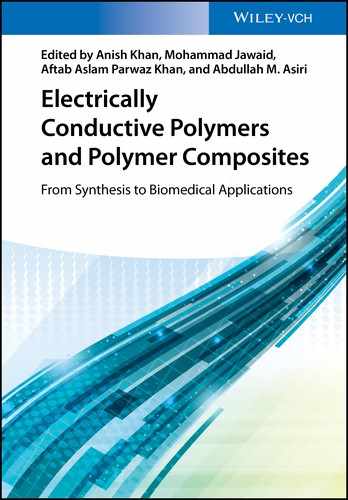Book Description A comprehensive and up-to-date overview of the latest research trends in conductive polymers and polymer hybrids, summarizing recent achievements. Show and hide more
Table of Contents
Cover Title Page Copyright Dedication About the Editors Preface Chapter 1: Bioinspired Polydopamine and Composites for Biomedical Applications 1.1 Introduction 1.2 Synthesis of Polydopamine 1.3 Properties of Polydopamine 1.4 Applications of Polydopamine 1.5 Conclusion and Future Prospectives References Chapter 2: Multifunctional Polymer-Dilute Magnetic Conductor and Bio-Devices 2.1 Introduction 2.2 Magnetic Semiconductor-Nanoparticle-Based Polymer Nanocomposites 2.3 Types of Magnetic Semiconductor Nanoparticles 2.4 Synthetic Strategies for Composite Materials 2.5 Biocompatibility of Polymer/Semiconductor-Particle-Based Nanocomposites and Their Products for Biomedical Applications 2.6 Biomedical Applications References Chapter 3: Polymer–Inorganic Nanocomposite and Biosensors 3.1 Introduction 3.2 Nanocomposite Synthesis 3.3 Properties of Polymer-Based Nanocomposites 3.4 Electrical Properties 3.5 Optical Properties 3.6 Magnetic Properties 3.7 Application of Polymer–Inorganic Nanocomposite in Biosensors 3.8 Conclusions References Chapter 4: Carbon Nanomaterial-Based Conducting Polymer Composites for Biosensing Applications 4.1 Introduction 4.2 Biosensor: Features, Principle, Types, and Its Need in Modern-Day Life 4.3 Common Carbon Nanomaterials and Conducting Polymers 4.4 Processability of CNTs and GN with Conducting Polymers, Chemical Interactions, and Mode of Detection for Biosensing 4.5 PANI Composites with CNT and GN for Biosensing Applications 4.6 PPy and PTh Composites with CNT and GN for Biosensing Applications 4.7 Conducting Polymer Composites with CNT and GN for the Detection of Organic Molecules 4.8 Conducting Polymer Composites with CNT and GN for Microbial Biosensing 4.9 Conclusion and Future Research References Chapter 5: Graphene and Graphene Oxide Polymer Composite for Biosensors Applications 5.1 Introduction 5.2 Polymer–Graphene Nanocomposites and Their Applications 5.3 Conclusions, Challenges, and Future Scope References Chapter 6: Polyaniline Nanocomposite Materials for Biosensor Designing 6.1 Introduction 6.2 Importance of PANI-Based Biosensors 6.3 Polyaniline-Based Glucose Biosensors 6.4 Polyaniline-Based Peroxide Biosensors 6.5 Polyaniline-Based Genetic Material Biosensors 6.6 Immunosensors 6.7 Biosensors of Phenolic Compounds 6.8 Polyaniline-Based Biosensor for Water Quality Assessment 6.9 Scientific Concerns and Future Prospects of Polyaniline-Based Biosensors 6.10 Conclusion References Chapter 7: Recent Advances in Chitosan-Based Films for Novel Biosensor 7.1 Introduction 7.2 Chitosan as Novel Biosensor 7.3 Application 7.4 Conclusion and Future Perspectives Acknowledgment References Chapter 8: Self Healing Materials and Conductivity 8.1 Introduction 8.2 Classification of Self-Healing Materials 8.3 Conductivity in Self-Healing Materials 8.4 Current and Future Prospects 8.5 Conclusions References Chapter 9: Electrical Conductivity and Biological Efficacy of Ethyl Cellulose and Polyaniline-Based Composites 9.1 Introduction 9.2 Conductivity of EC Polymers 9.3 Conductivity of PANI Polymer 9.4 Biological Efficacy of EC and PANI-Based Composites 9.5 Summary and Conclusion Acknowledgments References Chapter 10: Synthesis of Polyaniline-Based Nanocomposite Materials and Their Biomedical Applications 10.1 Introduction 10.2 Biomedical Applications of PANI-Supported Nanohybrid Materials 10.3 Conclusion Acknowledgment References Chapter 11: Electrically Conductive Polymers and Composites for Biomedical Applications 11.1 Introduction 11.2 Conducting Polymers 11.3 Conductive Polymer Composite 11.4 Biomedical Applications of Conductive Polymers 11.5 Future Prospects 11.6 Conclusions References Index End User License Agreement
